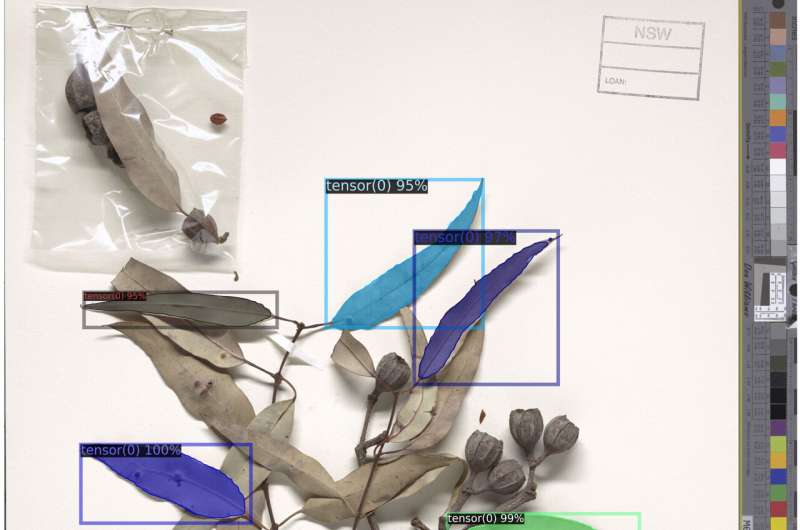This article has been reviewed according to Science X's editorial process and policies. Editors have highlighted the following attributes while ensuring the content's credibility:
fact-checked
peer-reviewed publication
trusted source
proofread
AI helps reveal history of iconic Australian tree

Scientists have harnessed new developments in machine learning to look at Australian eucalypt species, unveiling their transformation over millions of years.
Advancements in artificial intelligence have helped scientists explore the evolutionary history of an iconic Australian tree, which scientists say could help tackle threats like climate change and biodiversity loss.
In the study, scientists at Botanic Gardens of Sydney and UNSW Sydney used AI to analyze an unprecedented number of leaves from eucalypts (Eucalyptus, Angophora and Corymbia), gaining phenomenal insight into how this native species has evolved with climate.
The paper, published in the Journal of Ecology this week, analyzes a dataset of more than 50,000 digitized images of eucalyptus specimens, some dating back as far as 1839, to reveal if species' leaves have evolved as their climate does.
It follows last year's research, where scientists from Botanic Gardens of Sydney and UNSW built a machine learning program to examine millions of plant specimens stored in herbaria around the world. This approach introduced a resource that was previously inaccessible to researchers, as the sheer size of the herbaria collections had been too large for humans to measure.
In this first study, the team analyzed 3,000 samples of the species Syzygium and Ficus, using a "computer vision" method to look at their leaf sizes. They discovered that—contrary to frequently observed interspecies patterns—leaf size within species doesn't increase in warmer and wetter climates.
Now, a team of researchers have taken this work a step further, turning to one of Australia's most iconic and beloved trees, the eucalypts—to understand how its leaf sizes have changed with climate over millions of years.
Botanic Gardens of Sydney scientist Karina Guo says the study shows how AI is changing botanical science.
"Using AI, we've been able to work with huge amounts of data, which was simply not possible before," Guo says. "It's changed the game in finding the minutia of flora, helping us to paint a very detailed picture of the past.
"Instead of manually assessing thousands of images of specimens, which can take years, the machine learning can look at tens of thousands in less than four days."
UNSW Researcher Associate Professor Will Cornwell describes this new ability to unveil previously inaccessible data as groundbreaking.
"Digitized specimens have allowed us to dive deeper in understanding our species like never before, which can ultimately help us to tackle big threats to our flora like climate change and biodiversity loss," A/Prof. Cornwell says.
More information: Karina Guo et al, Using machine learning to link climate, phylogeny and leaf area in eucalypts through a 50‐fold expansion of leaf trait datasets, Journal of Ecology (2024). DOI: 10.1111/1365-2745.14354
Journal information: Journal of Ecology
Provided by University of New South Wales


















